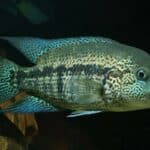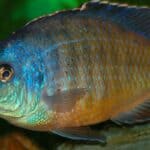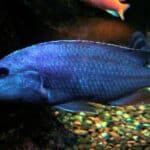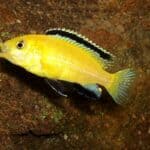Firemouth Cichlids are a colorful and attractive species of tropical freshwater fish. They are active swimmers and their vibrant appearance makes them a very popular choice for domestic aquariums.
They are considered fairly easy to look after as they don’t need as much space as other species of freshwater fish. This could be a good choice of fish if you are a beginner aquarist.

If you are considering housing this lovely species in your home aquarium or you just want to find out more about them, then carry on reading. We will provide you with all the information you need about their diet, behaviour, tank requirements and more.
Species Summary
This species originates in Central America and is largely found in the rivers in Mexico. The waters there are warm and shallow with a gentle flow. They also live in canals, ditches, lagoons and rocky ponds, where the substrate is muddy or sandy. The water is often murky with sediment.
They have been traded and released into the wild in various other countries around the world where they are considered an invasive species.
Firemouth Cichlids get their name from the orange coloring under their mouths. Males will flare their gills whilst asserting dominance and defending their territory, making this patch of color more visible.
Care Guide
Tank Size
These fish need a minimum tank size of 30 gallons. This gives them enough room to swim, but is still an easy size to fit into most homes. If you have space to provide them with a bigger thank then they would appreciate it, as they can be territorial.
If you want to keep more than one fish in the same tank, we recommend increasing the tank size by 10 gallons for every additional fish, but the more space the better to avoid territory disputes.
Tank Mates
Firemouth Cichlids are mostly a docile species, aside from some territorial aggression. If you choose tank mates that will mostly leave them alone, they will get along just fine.
If you house them with smaller fish, they might pick on them, but if you go for a species that is significantly larger they will feel threatened. Even if the large fish is docile, your Cichlids will be living in a constant state of anxiety which is very bad for their health.
We recommend that you choose fish of a similar size, like Clown Pleco, Cory Catfish, Kuhli Loach, Rainbow fish and Swordtails.
Do not house Firemouth Cichlids with shrimp or aquatic snails/crustaceans, as they will try to eat them.
Same Species Tanks
Firemouth Cichlids are territorial and do not live in groups in the wild. They can be happy in a small community of their own species if they have plenty of space and do not feel cramped or overcrowded. To be on the safe side, it is probably best to have less males than females in the group.
Water Parameters
To replicate the tropical waters of Central America, the water temperature will need to be within 75 and 86 degrees fahrenheit. The PH level should be between 6.5 and 8.0, and the water hardness anywhere within 8-15 KH.
Tropical fish are particularly sensitive to nitrate levels in the water so it is very important that you have a good quality water filter. Perform regular water checks to make sure the water conditions are safe for your fish.
What To Put In Their Tank
These fish like to dig around in the substrate level so it is best to go for sand rather than gravel to avoid them scratching themselves. Avoid sharp sand, as they will filter through the substrate for food and expel the sand through their gills.
Firemouth Cichlids will be happiest with spaces they can occupy and claim as their territory, like artificial caves and decorative rocks and driftwood.
They also like to have some plant life around them. Make sure you choose robust plants as they will swim through them and play with them- delicate plants will be destroyed quickly.
Common Diseases
This species is not vulnerable to any particular kind of disease, but like any fish in a freshwater aquarium, they can contract fungal or bacterial infections. Make sure you keep the tank clean to prevent this from happening.
Keep an eye out for Ich, a parasite which can be spotted by the white spots it causes on the skin. If you suspect that one of your fish is infected then place them in a quarantine tank as soon as possible to prevent further spread to other fish in the tank.
Food & Diet
Firemouth Cichlids are not fussy eaters, but you should still make the effort to provide them with the right food to ensure they have a nutrient rich diet.
In the wild they are omnivorous, eating crustaceans and the occasional bit of vegetation. A good quality flake or pellet fish food is a good option, supplemented with live food like brine shrimp or bloodworms. You can try them on some vegetables cut up small, but they might not eat it. Be sure to remove any uneaten vegetables from the tank.
Feed them every other day to avoid them overeating. They should be eating for no longer than 2 minutes at a time.
Lifespan
The average lifespan of a Firemouth Cichlid in captivity is 10 years. They have been known to live as long as 15 years if they are incredibly well cared for. To maximise the lifespan of your fish, maintain the correct water conditions and a nice clean tank.
Feed them a nutritious diet and ensure they do not get stressed. The lifespan and health of your fish will also depend on the condition it was in when you bought it and how it was bred, so ensure you are getting your fish from a reputable breeder.
Appearance
The coloring of Firemouth Cichlids is what sets them apart from other fish found in a freshwater aquarium.
Their bodies are pearlescent turquoise with red coloring around the edge of the scales which stands out against the silvery blue. They also have a large patch of black scales on their operculum. They have ray-fins, which are also colorful like their bodies.
In the wild, Firemouth Cichlids can adapt their coloring to their surroundings and the plant life. The most colorful variations have been seen in Guatemala.
Size
The average size of male Firemouth Cichlids is 6 inches. Females tend to grow to an average size of 5 inches. They grow quite quickly.
Behaviour & Temperament
These fish are categorised as semi-aggressive, but on the whole, Firemouth Cichlids are quite docile. They can be territorial, so if they don’t have enough space you can expect to see some displays of aggressive behaviour.
They spend a lot of time swimming in the middle level of the aquarium, and will dip down to the substrate layer to dig about for food before swimming back up again. Their active swimming patterns make them enjoyable to watch, especially with their bright colors on display.
Breeding
Breeding Firemouth Cichlids in a domestic tank is fairly straightforward. Before you begin the breeding process, be aware that Firemouth Cichlids will become more aggressive while they are mating, especially the males when they are trying to find a female to breed with. You can buy an already bonded pair, or let them choose their own mate from a group.
To encourage spawning, you can adjust the water parameters slightly. The temperature can be increased to 75 to 80 degrees fahrenheit and the PH level amended to between 7.0 and 7.2.
The females like to lay their eggs on a flat surface, preferably a smooth rock. Once she has laid her eggs, usually a couple of hundred of them, the male will fertilize them and guard them until they hatch.
Within a few days of hatching, the smallfry will be swimming and will be big enough to eat microworms or brine shrimp.
Gender Differences: Male vs Female
As juveniles, these fish are difficult to sex. Once they have fully matured, there are a few differences between male and female Firemouth Cichlids which you can use to tell them apart.
The first is their coloring. The orange and red on the males is more vibrant.
The Males also have longer fins, whereas females have a rounder body shape around the belly.
And finally, you can compare their size. Males are usually larger than females by about one inch.
Fun Facts
- Firemouth Cichlids scientific name is Thorichthys meeki, which is ancient Greek for ‘leaping fish’. Make sure you have a tight lid on your tank!








